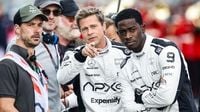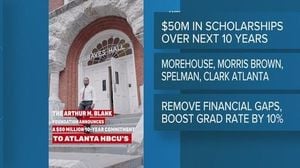When the Seattle Kraken took to the ice for their 2025-26 season opener, few expected a Hollywood twist to emerge from the locker room. But after their 3-1 victory over the Anaheim Ducks on October 9, the team unveiled a new post-game tradition: awarding a replica helmet from the blockbuster film F1 as the "player of the game" prize. The helmet, modeled after the one worn by Brad Pitt’s character Sonny Hayes in the movie, isn’t just a flashy prop—it’s a symbol of inspiration, resilience, and a unique connection between sports and cinema that’s captured imaginations on both sides of the Atlantic.
The story behind this unusual award begins with Jerry Bruckheimer, the legendary producer behind both the Seattle Kraken and F1, the film that has taken the summer box office by storm. According to Crash.net, Bruckheimer, who is also an investor in the Kraken, arranged for the team to receive an advance screening of F1 before its official release. The film, directed by Joseph Kosinski and co-produced by seven-time Formula One world champion Lewis Hamilton, stars Brad Pitt as Sonny Hayes—a once-great driver making a comeback three decades after a career-ending crash. Since its release, F1 has grossed over $600 million, cementing its place as a cultural phenomenon.
For Kraken head coach Lane Lambert, the film’s message of perseverance and redemption struck a chord. He saw in Sonny Hayes’s journey a parallel to the kind of grit and determination he wanted to instill in his players. Inspired, Lambert asked Bruckheimer if the team could get a replica of the Sonny Hayes helmet to use as a post-win honor. As Bruckheimer recounted in an interview with the Kraken, “It’s a really cool idea. I mean, they’re really cool helmets.” He explained that Bell Racing, the company responsible for the original movie helmet, was enlisted to create an extra-large version suitable for hockey players. “So, it’s the exact helmet that we used in the movie; it’s just a larger size,” Bruckheimer said.
The helmet made its debut after the Kraken’s opening night win, with goaltender Joey Daccord—who, fittingly, hosts his own F1 video series on social media—becoming the first recipient. Just days later, after a dramatic overtime victory against the Vegas Golden Knights on October 11, forward Jared McCann was awarded the helmet for netting the game-winner with only four seconds left on the clock. The tradition has quickly become a symbol of team pride and a tangible link to the high-octane world of Formula One racing.
But the helmet is more than just a trophy—it’s a testament to the impact F1 has had beyond the silver screen. The film’s authenticity and emotional resonance have been widely praised, thanks in large part to the hands-on involvement of Lewis Hamilton. At a recent awards campaign event at the Academy Museum in Los Angeles, director Joseph Kosinski credited Hamilton as the “secret ingredient” behind the film’s success. “We could not have made it without his help every step of the way,” Kosinski told attendees, as reported by Gold Derby. Hamilton’s input extended from technical guidance—ensuring every gear shift and racing line was accurate—to inspiring some of the film’s most poignant moments. Kosinski recalled a conversation with Hamilton that shaped a key scene: “He told us about that, and he said to me, ‘The car disappears.’ I instantly knew how to shoot that scene, and that is an amazing gift you can only get from someone who lives and breathes it every day.”
Hamilton himself described working on the film as “unbelievable” and a realization of his “biggest dream.” But what mattered most to him was the film’s realism. “If you look at a lot of the movies before that filmed racing, they just didn’t quite capture it or keep you on the edge of your seat,” he said. Hamilton pointed to technological advances, including new camera systems developed in partnership with Apple and Sony, that allowed the filmmakers to capture racing action with unprecedented clarity. “The footage we have from the cars is better than what you see watching Formula One.”
The effort to portray Formula One authentically extended to the actors themselves. Producer Jerry Bruckheimer explained the unique challenges of depicting a sport where teammates are also fierce competitors. “There are only 10 teams, two drivers to each team, and it’s the only sport where your teammate is your competitor,” he said. To prepare, Brad Pitt and Damson Idris (who plays rising star Joshua) spent four months learning to drive real race cars, with Hamilton overseeing their progress. The actors trained at real tracks and, when filming took place during actual Formula One events, had to nail their scenes in just a handful of takes—sometimes with as little as 15 minutes to shoot three scenes back-to-back, according to Kosinski. “We’re trying to shoot a movie, and [the actors] know they’ve got two takes to get it and whatever they do is going to end up in the movie. That’s the price you pay for making a movie like this.”
For Brad Pitt, Sonny Hayes’s story is one of redemption—a theme that resonates far beyond the pit lane. “We’ve all stumbled in our lives. We’ve all had times where we’ve had to pick ourselves up when it seemed impossible, the odds seemed impossible, and get back in the fight,” Pitt said at the Academy Museum event. “That’s when we grow, that’s when we see the most growth, and that’s when we see the most rewards as individuals.”
The film also delves into the personal relationships that shape its characters. Damson Idris’s Joshua is driven by ambition, but his relationship with his mother, played by Sarah Niles, adds emotional depth. Niles credited the film’s writers and Hamilton’s oversight for helping her craft a character with real heart. “That’s when you understand the levels of how you create the whole story… I didn’t really understand until I watched the movie just how much heart is in the movie,” she said.
Behind the scenes, editor Stephen Mirrione faced the daunting task of weaving together race footage and over 5,000 hours of film to create a cohesive narrative. The result is a movie that not only entertains but also brings viewers closer to the adrenaline and drama of Formula One than ever before.
Now streaming on Apple TV+, F1 continues to inspire audiences worldwide—and, in Seattle, it’s sparked a new tradition that blends the worlds of hockey and racing in unexpected ways. As the Kraken chase victory this season, the Sonny Hayes helmet serves as a reminder that, whether on ice or asphalt, the spirit of the comeback is universal—and sometimes, a little Hollywood magic can make all the difference.




